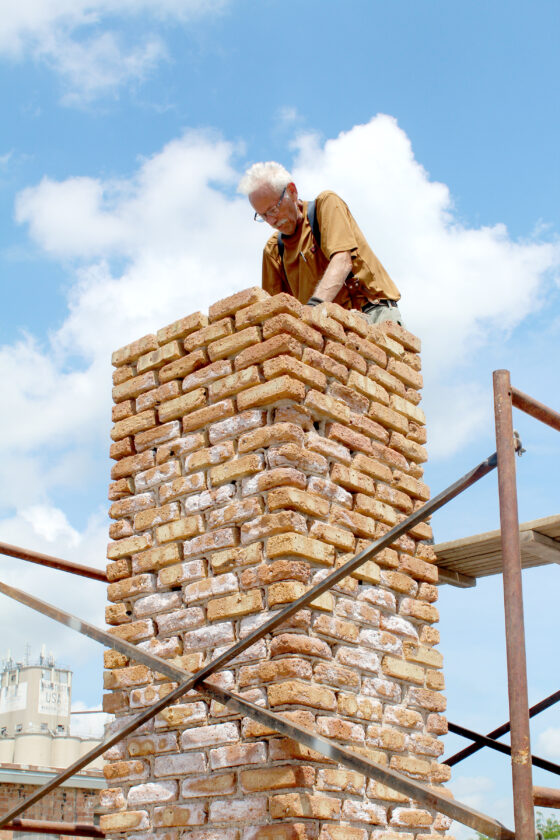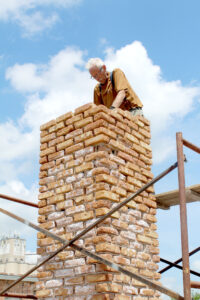A Webster City man fights to save his building — and his business
Part Two of a Series — For Chris McNeil, a city-imposed barricade is personal

DFJ photo: Licensed as an electrician, plumber and HVAC contractor, as well as a practical engineer for 32 years, Chris McNeil has a reputation as a problem-solver.
His light tan van is a familiar sight all over town. A fabricating shop and parts depot on wheels, it has most of what Chris McNeil needs on his daily rounds.
Licensed as an electrician, plumber and HVAC contractor, as well as a practical engineer for 32 years, McNeil has a reputation as a problem-solver.
A long-time customer calls him “Mr. Fix It.”
When the adjacent buildings at 518 and 520 Second Street came up for sale six years ago, McNeil bought them both.
“The place was decrepit, but I’ve worked on it persistently. I still have a lot I want to do here.”
He estimates he’s spent almost $100,000 on improvements to the two buildings.
Many readers will remember the building as home to Monroe Office Supply. The central location and ample floorspace provides a base for McNeil to store the large inventory of electrical, plumbing and HVAC parts required to serve his customers.
McNeil’s problems began when a spring 2025 storm dislodged a large window on the second floor at 520 Second Street. McNeil removed the glass and framed the window, intending to install sheet metal. Before the job could be completed, the city’s new building inspector informed McNeil revised city ordinances no longer permit blocking up windows with sheet metal.
McNeil could understand this ruling, if the apartments on the second floor of his buildings were occupied, but that hasn’t been true for at least the last 15 years. The windows have been open to the elements since May, and McNeil fears the second floor may now be infested with bats or birds.
To verify the condition of McNeil’s buildings, the City of Webster City hired Shuck-Britson, an engineering firm from Des Moines, to make a third-party assessment. Its report, dated May 29, 2025, concluded the building was unsafe and shouldn’t be occupied.
The city notified McNeil of this, but he continues to use the building, signing a waiver indicating he does so at his own risk.
The city also threatened to cut off utilities to the building, but that step has not been taken, at least at press time.
McNeil takes exception to some conclusions in the Shuck-Britson report.
“I’m all for public safety, and I intend to make repairs if I’m given adequate time by the city, but this situation isn’t an emergency. In my view, there’s no hazard to the public as things stand now.”
The engineering report, McNeil asserts, contains unrealistic demands.
“They want me to strip the plaster off my basement walls so masonry joints can be inspected. That’s a costly undertaking. I don’t see why 100-year-old buildings are held to the same standards as modern ones. The Europeans are a lot smarter about this. Times change, businesses move in and out, but the buildings remain the same. They’re treated as historical rather than out of date.”
McNeil continues: “It’s no mystery why there’s so little historical preservation in the country. None of the banks around here would consider lending money for those projects, anyway. The numbers don’t work out.”
McNeil called the city’s treatment of his case “heavy-handed.” He described Anna Siegrist, the Shuck-Britson engineer who inspected his building, as “disrespectful.”
McNeil, who will be 70 next February, has clearly been affected by the worry and anxiety regarding the engineering report, barricades and potential expenses.
“My business has suffered terribly since the barricades went up. I’m spending way too much time defending myself rather than working.”
He feels his building has been singled out, while others get a pass.
“At the time the barricades went up at my place, I saw a portable toilet right next to the Hubbard Building (547 Second Street), which is also barricaded on Market Night. How is that safe? Anybody can see the fatal crack in the Lotus building, running from the ground to the roof. Is that dangerous? The thrift store has stayed open, so it must not be too bad.”
At his building, the Shuck-Britson report referred to “buckling bricks,” but McNeil says there are none.
“The rumor of buckling bricks is false. My building was barricaded, making repairs next to impossible for me, based on this faulty information.”
So concerned is McNeil over the threats to his building and business, he asked a realtor to search for other buildings.
“They came up with three possibilities, all old buildings filled with surplus household or business goods of deceased former owners.”
On June 5, McNeil went to a meeting at City Hall to discuss the situation.
“The option they offered was a quit-claim deed, for me to just abandon the place and sign it over to the city, who would then be faced with using tax money to make repairs or tear it down. I’ve got too much to lose and won’t be doing that.”
Instead, McNeil is now making repairs to his property. He’s done some of the work himself, and has looked into hiring professional masons to do some work on the buildings’ exterior.
McNeil’s bottom line is unmistakable.
“This is a great location for my business. I’m doing all I can to stay right here.”
Part 3 of this four-part series will be published on August 11.

